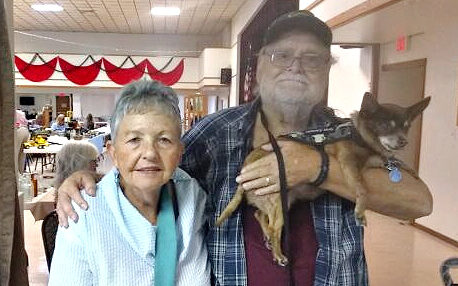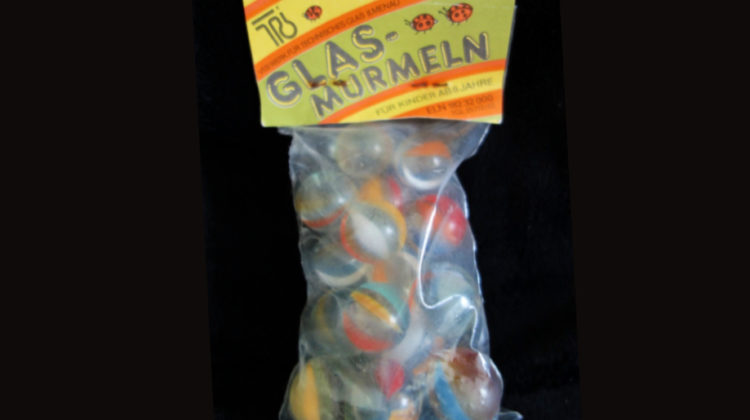
Think About It
Do you have any brand new machine-made marbles from either Ilmenau or Laschau glass houses in Germany? Neither do we. But why not? Why can’t we buy new German machine-made marbles? Did you ever think about this? “This is the end of a story that even people who are not usually amazed at anything may refuse to believe. But I am armed in advance against human incredulity.” Jules Verne, Axel in Journey to the Center of the Earth (1864)
A Quick Look Back
Consider this: a hand-blown glass workshop was established in Lauscha as early as 1597, but glass making in some form there dates to the 1300s. In our comprehensive story The Lauschaer Glashütte and the Origins of Modern Glass Marbles we explain that Lauscha glass can be traced all the way back to Roman times in Germany.
There is a section in the The Lauschaer Glashütte… story called “For the Love of Place”. In that section we consider the special bonds between people and where they live. Glassworks were developed in Lascha because of both the physical geography of the place and the character, heritage, and grit of the people who live in mountains of the Thuringian forest in the green heart of Germany.
Ilmenau Marbles
So, back to the question. Why can’t we buy brand new machine-made marbles from Lauscha which have this ancient heritage? We had never seriously considered it until we recently found these Ilmenau marbles in an antique shop in Daphne, Alabama.
We regret that we cannot offer a crystal-clear photograph of these marbles. While the plastic bag isn’t particularly old, it is cloudy. These marbles are called ‘beach ball” by collectors and they are remarkably beautiful. You can see a number of brilliant photographs of different types of Ilmenau marbles at The Marble Connection.[1]
Autobahn or No, All Roads Lead to Ilmenau
It only took one email to our dear friend and colleague Dr.-Ing. Gerhard Greiner-Bär, who is a long-time resident of Lauscha, to establish the relationships between Ilmneau and Lauscha. Dr. Greiner-Bär is an expert on the history of Lauscha and its glassmakers as well as German glass marbles.
First, both Ilmenau and Lauscha are in Thurgenia. Ilmenau is only about 32 driving miles almost due north of Lauscha. It lies at an elevation of about 1600 feet. Ilmenau is a larger town than Lauscha with some 36,000 people as compared to Lauscha with only about 3,700.
About 7,200 students in Ilmenau study at the The Technische Universität Ilmenau which is a public institution. The town itself is around 800 years old.[2]
Thuringia
There are countless winding country roads and hiking trails in this green heart of Germany. The Thuringian Forest hosts the popular hiking system the Rennsteig. And people visit the State for both winter and summer sports including a sled dog race!
Thuringia is a small state and, by German standards, is relatively poor. Unemployment remains high. “The state’s economy is now largely dependent upon service-sector activities, but industrial production, though diminished since 1990, is still important. The principal manufactures are automobiles and auto parts, metalworking, precision machinery and instruments, optics, electrical equipment, a much diminished textile sector, and biotechnology. Glass, wood, and toy industries are found in some towns of the forest valleys.”[3]
The Stage is Set; Bring on the Actors!
In our story The Lauschaer Glashütte and the Origins of Modern Glass Marbles we established the long complicated history and background of marble making in Lauscha. When we emailed Dr. Dr. Greiner-Bär about marble making in Ilmenau, he directed us to page 35 of his unparalleled book Lauschaer Glasmärbel — und die Welt der Murmeln.
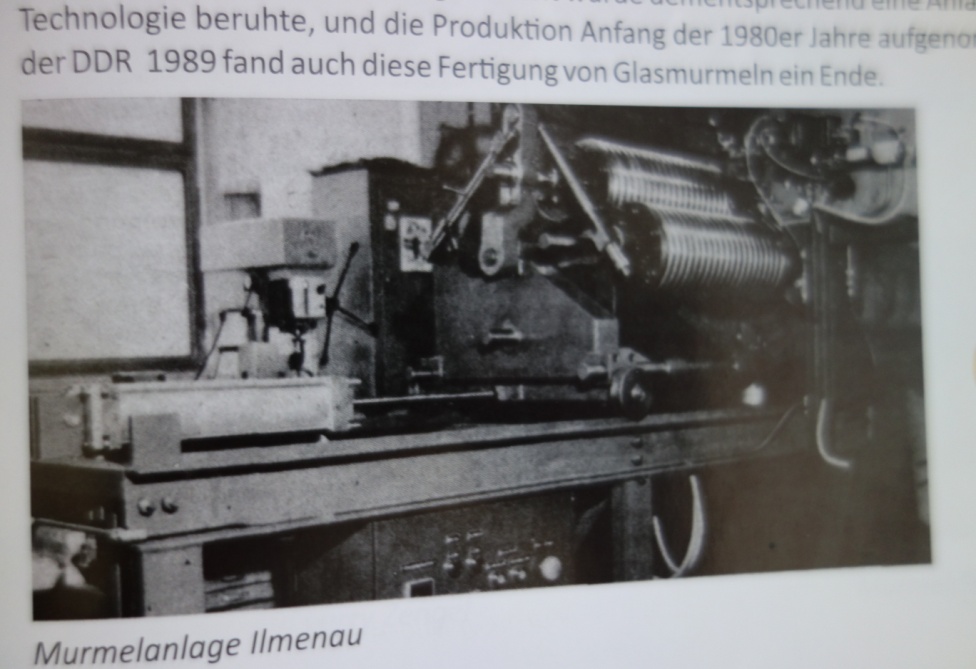
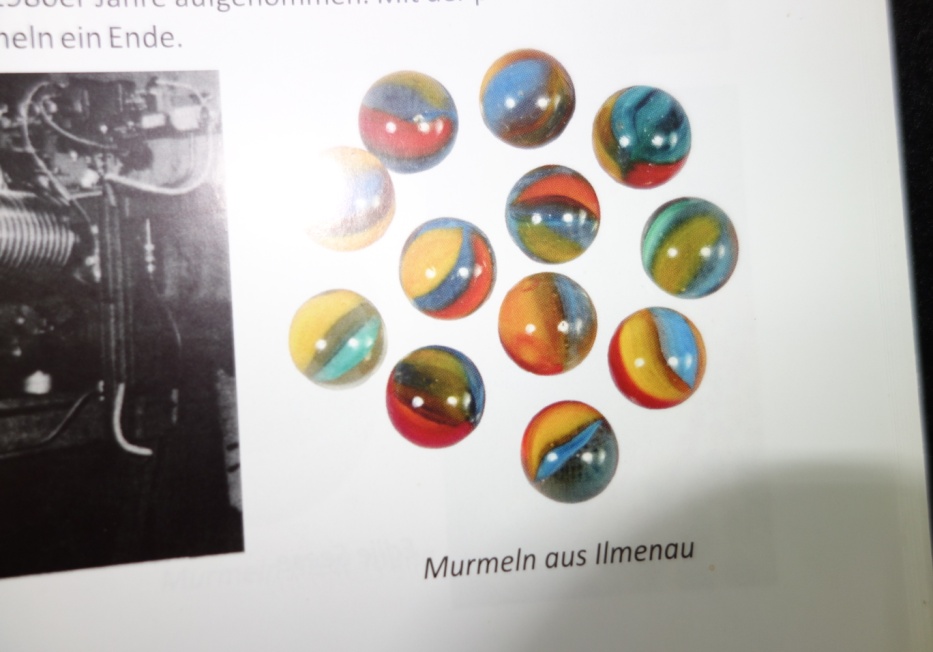
While we had studied Dr. Greiner-Bär’s book systematically when we wrote our story, we did not remember reading this section. That’s probably because we had not made the connections between Ilmenau and Lascha glass at the time. Dr. Greiner-Bär explained it for us both in the book and through his emails.
The photograph to the left, above, is the marble machine at Ilmenau while the marbles in the photograph to the right were made on this machine.[4]
GDR; DDR
The German Democratic Republic (GDR), (in German: Deutsche Demokratische Republik DDR), existed from 1949 until the fall of the Berlin Wall in late 1989. The GDR covered the area of the present-day German states of Thüringen, Mecklenburg-Vorpommern, Brandenburg, Berlin (excluding West Berlin), Sachsen, and Sachsen-Anhalt.
Dr. Greiner-Bär continues the Ilmenau-Lauscha saga: “After the ‘Seppen’[5] in Lausha in the GDR shut down the production of marbles in the 1970s, there was a domestic need for marbles that could not be covered by imports, since the necessary foreign exchange for the purchase of modern machines, equipment and raw materials were needed.”
In the GDR-Lauscha, an economy of scale was needed. In order to achieve any such scale in production, investment, and distribution, hard foreign currency was needed. It was an impossible bind to escape and the alternative, shutting down production of marbles, was inevitable in this case.
Dr. Greiner-Bär: “In addition, there was a demand on the state-owned enterprises to earn as much foreign currency as possible in foreign trade.”[6]
After the formation of the GDR and “under Soviet rule, many families lost their businesses to the communist state. Local craft workshops and companies ceased production until … 1989. During that time, state-owned companies produced machine-blown Christmas tree decorations [in Lauscha], and local craftspeople fought to keep their skills alive, teaching new generations and preserving time-honored techniques. The art of glassblowing survived….”[7]
Marble Making in Ilmenau GDR
Dr. Greiner-Bär tells us that the Technical Glass Combine was opened in 1980 in Ilmenau to make marbles, and the combine made the marbles shown in this photograph. “In the … Combine in Ilmenau, the production of marbles was seen as an opportunity to cover domestic needs and to earn valuable foreign [hard] currency.”
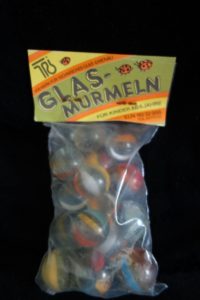
The communist state had, by the time the Combine was established, decided, as explained above, that these marble goals could not be accomplished in Lauscha.
Dr. Greiner-Bär: “Therefore, it was decided to develop such a fully automatic system for the production of marbles and to start production. Accordingly, in years of work, a system was developed that was based on the known technology, and production started in the early 1980s.”
However, Ilmenau marble making was short lived. “It ended in 1989 with the political change in the GDR. The combine technical glass Ilmenau had about 12,600 employees in about 30 companies in Thuringia. There were around 5,000 employees at the Ilmenau site. The Technische Glaswerk Ilmenau, which remained after 1992, had around 225 employees and went bankrupt in 2014 and was shut down in 2015.”
Hard Times in the Neighborhood[8]
“After German unification in October 1990, the economic performance of western Germany was initially strong. However, it deteriorated by 1992 and remained dismal for the remainder of the 1990s. During this time, the unemployment rate nearly doubled, as GDP growth averaged a meager 1.5 percent per year.”[9]
After an economic upturn in the former West Germany directly after reunification, things took a downward economic spin all across Germany after 1990 to include both Ilmenau and Lauscha. However, Ilmenau had a much more diversified economy in 1990 than Lauscha. Ilemnau had begun wide industrialization after the railway arrived there in 1879.
True, their long history of porcelain production came to a close in the 1990s as the factories closed, but they did keep their glass industry. Workers produced glass laboratory equipment and measurement devices. And mechanical, electrical, and software engineering slowly expanded.[10]
So, with the end of the Soviet era, German large-scale marble production not only in Thuringia but all across Germany came to an end. Dr. Greiner-Bär tells us that “in Germany, designer marbles are only manufactured in Lauscha.” That is, contemporary art marbles are still made in one of the twenty or so shops in Lauscha, but no production runs.
UNESCO and Intangible Cultural Heritage
The artisans in Lauscha struggled after the fall of the Berlin Wall to keep their economy and their artistic expressions alive. Well, Unesco has recognized that the glass blowing in Lauscha deserves the designation of not only a Cultural Heritage but an Intangible Cultural Heritage! 
Read current information on saving their heritage at Lauscha Glaskunst .
From the UNESCO https://whc.unesco.org/en/faq/40: “Intangible cultural heritage is the practices, expressions, knowledge and skills that communities, groups and sometimes individuals recognise as part of their cultural heritage. Also called living cultural heritage, it is usually expressed in one of the following forms: oral traditions; performing arts; social practices, rituals and festive events; knowledge and practices concerning nature and the universe; and traditional craftsmanship.”
So, the centuries-old craft of mouth-blown glass ornaments has come to “symbolize the perseverance and passion of the region’s craftspeople.” [11] This is only as it should rightfully be. We propose in The Lauschaer Glashütte and the Origins of Modern Glass Marbles that it was this very German grit, skill, determination, and craftsmanship which led to the development of the glassworks in Lauscha in the first place.
Another Chapter Closed, but the Book Continues
The Soviet period in Thuringia was brutal in many ways. Economic impacts were felt long after reunification. However, as Unesco recognizes, all is certainly not lost in Lauscha! Life and art do go on! And they are vibrant!
According to the Daily Mail[12] “Today there are still about 20 small glass-blowing firms active in Lauscha and to celebrate this festive heritage, a famous Christmas Ball-market takes place every year which attracts thousands of visitors to this snow topped picturesque location.”
We will never be able to visit Lauscha, but perhaps you will. In the meanwhile why not check out Karen Leblanc’s story “Christmas Crafts from the Village of Lauscha”? It is a wonderful travel story and visual of the magic and mystery of the Village today.
And, the next time you have an opportunity to buy a bag of Ilmenau marbles why not add them to your collection? When you buy them, think about what those gorgeous glass marbles really are and the times they represent.
Frohe Weihnachten und vielen Dank, dass Sie unsere Geschichte gelesen haben!
- Specifically check : “Two from Technische Glaswerke Ilmenau” @ https://marbleconnection.com/topic/27514-two-from-technische-glaswerke-ilmenau/?_fromLogin=1#replyForm (6/30/2023) and “Euro machine made celebration” (Some text & photographs) @ https://www.allaboutmarbles.com/viewtopic.php?f=5&start=100&t=45184&sid=6b60ae3db01599328250f9106ed83c2d 6/30/2023↑
- You can read more about the town @ https://www.expatrio.com/living-germany/cities/ilmenau 6/28/2023 ↑
- Ibid. ↑
- Dr. Greiner-Bär could not locate the digital photographs he used in his book but he gave us permission to use these two photos from page 35. The quality of the photographs in the book is excellent and we take full credit for our poor quality. While this is an Ilmenau machine, we have no idea how many were used. ↑
- The “Seppen” being, of course, that loose confederation of glass marble makers in Lauscha explored in detail in our story The Lauschaer Glashütte and the Origins of Modern Glass Marbles ↑
- The Seppen glassworks in Lauscha had once exchanged glass for hard currency from Britain (Queen Victoria loved the Christmas ornaments) and America. “In the 1880s the American dime-store magnate F. W. Woolworth discovered Lauscha’s Glaskugeln [glass balls: Christmas ornaments] during a visit to Germany. He made a fortune by importing the German glass ornaments to the U.S.” And don’t forget, the artificial human eye was invented in the 1830s in Lauscha and these, too, brought in hard currency. See: https://www.dailymail.co.uk/news/article-2242631/Christmas-tree-decorations-Small-German-mountain-village-Lauscha-birthplace-bauble.html 6/30/2023 ↑
- Story by The Design Tourist – Karen LeBlanc : “Exploring Lauscha, Germany, The Cradle of Christmas Crafts and Ornaments.” @ https://www.msn.com/en-us/travel/tripideas/the-design-tourist-exploring-lauscha-germany-the-cradle-of-christmas-crafts-and-ornaments/ar-AA18bCgO 6/28/2023 ↑
- Darrell Scott, “It’s a Great Day to be Alive.” Recorded by Travis Tritt in 2000. ↑
- Levy Economics Institute of Bard College. PDF “The Economic Consequences of German Unification” @ https://www.levyinstitute.org/ 7/4/2023 ↑
- https://en.wikipedia.org/wiki/Ilmenau 7/4/2023 ↑
- Karen LeBlanc : “Exploring Lauscha, Germany, The Cradle of Christmas Crafts and Ornaments.” @ https://www.msn.com/en-us/travel/tripideas/the-design-tourist-exploring-lauscha-germany-the-cradle-of-christmas-crafts-and-ornaments/ar-AA18bCgO 6/28/2023 ↑
- https://www.dailymail.co.uk/news/article-2242631/Christmas-tree-decorations-Small-German-mountain-village-Lauscha-birthplace-bauble.html 6/30/2023 ↑
Reader Feedback
Thank you very much. It’s always interesting and refreshing to read your stories. Please keep up with the good work! Dr. Gerhard Greiner-Barr, Lauscha, Germany.

